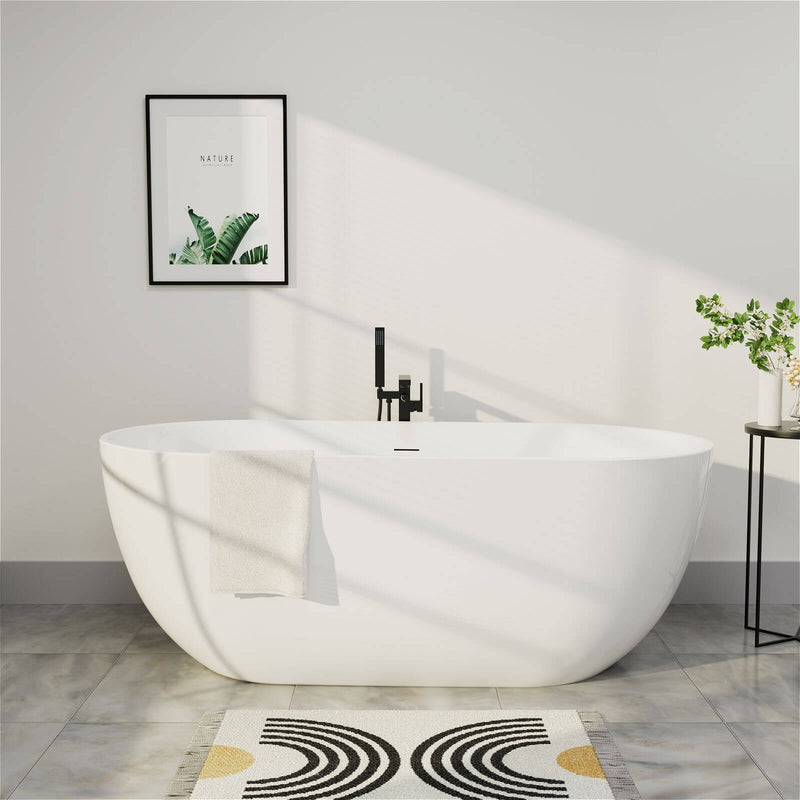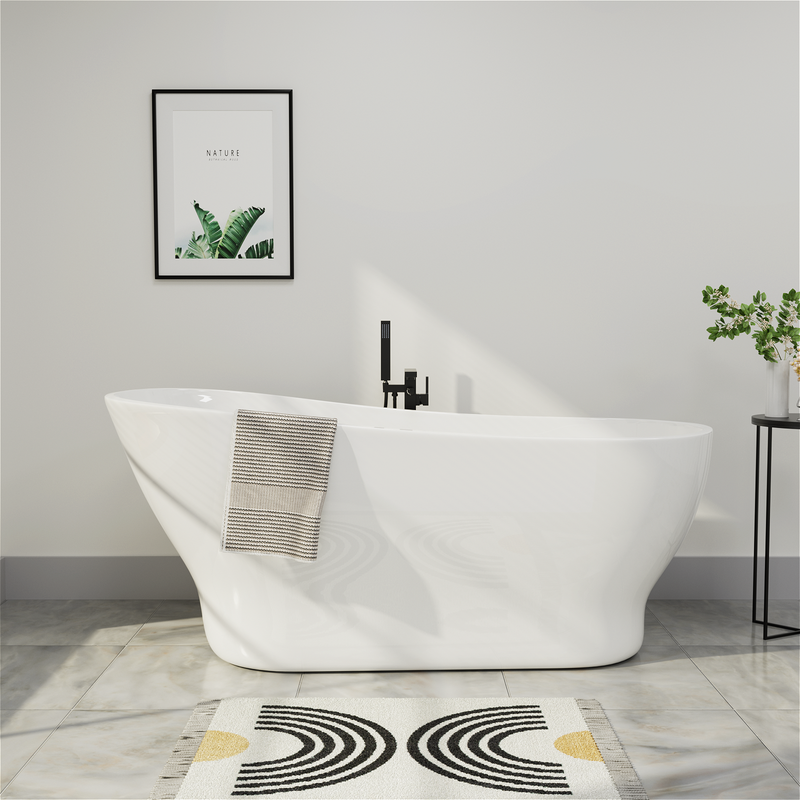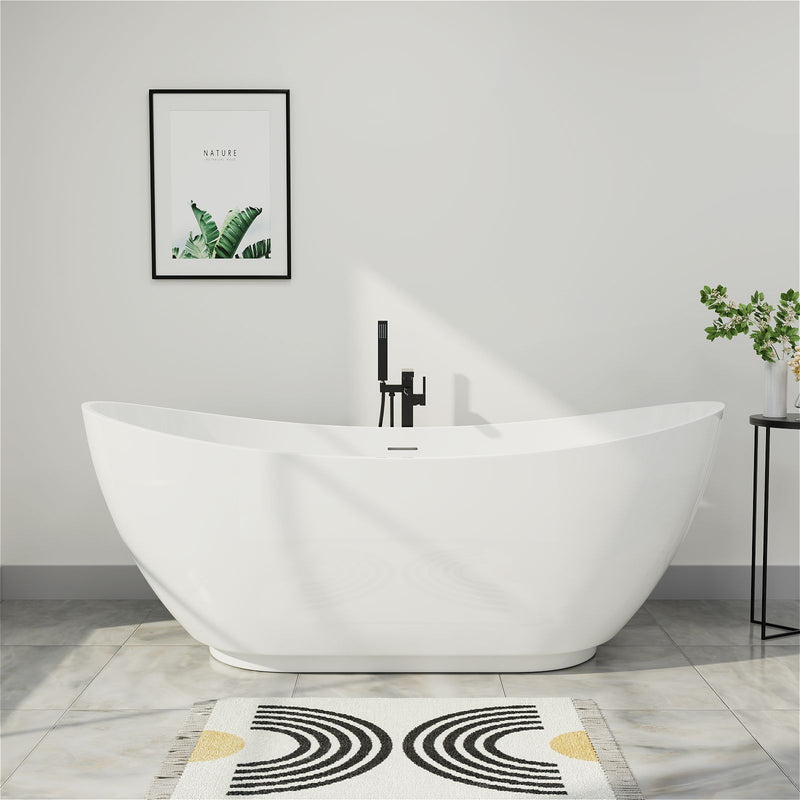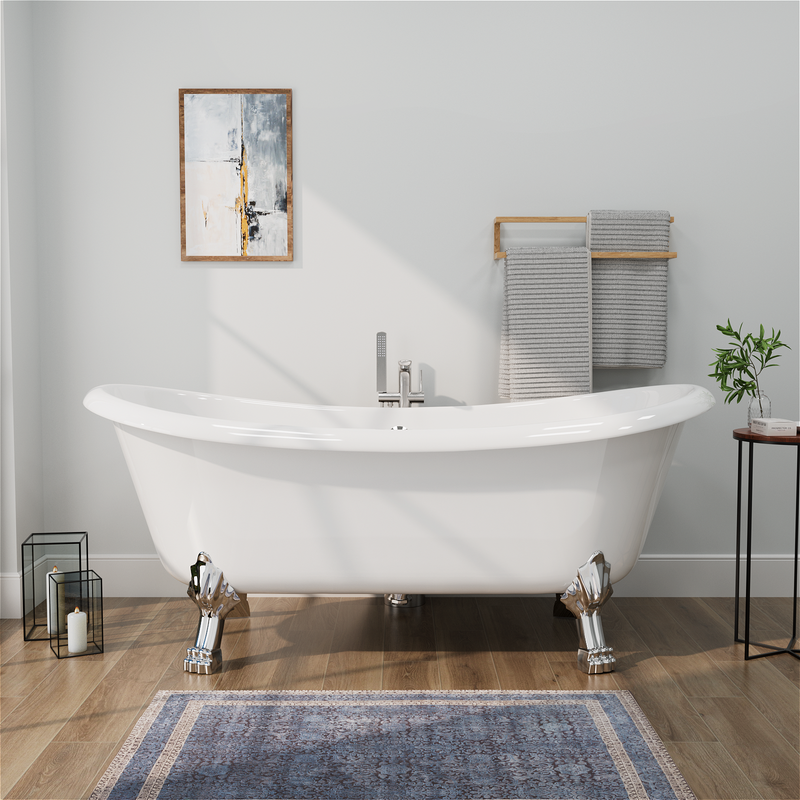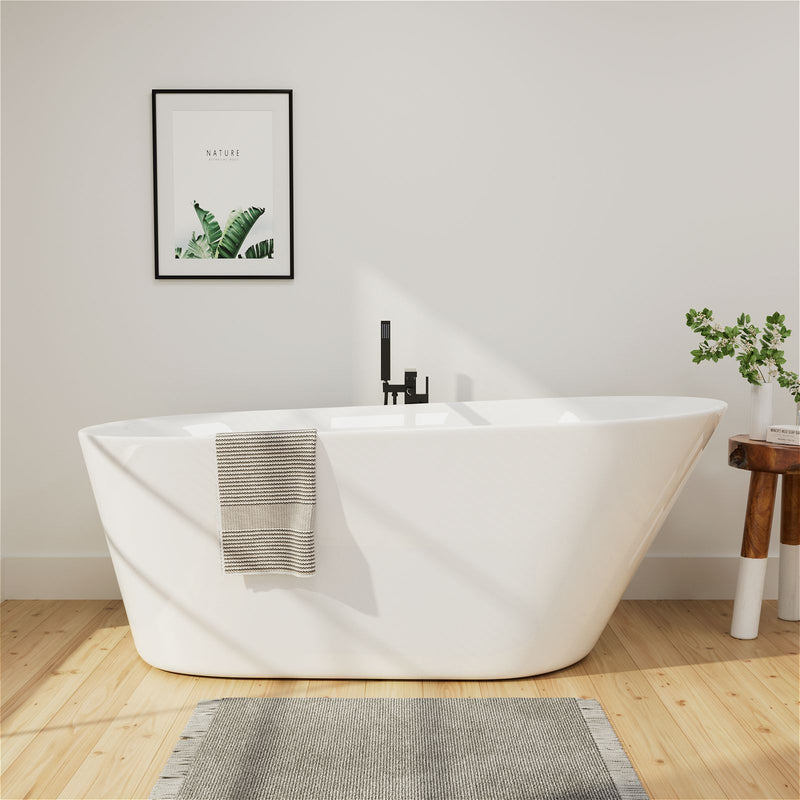Designing a small bathroom doesn't mean giving up on comfort or style. One of the most effective ways to create a spa-like atmosphere in limited square footage is by adding a slipper bathtub. Known for their raised backrest and compact footprint, slipper tubs offer deep soaking comfort without consuming valuable floor space.
In 2025, more homeowners and designers are prioritizing efficiency and relaxation, turning small bathrooms into functional retreats. Slipper tubs—especially compact freestanding and acrylic models—have become central to this transformation. This guide explains how to choose the best slipper tubs for small bathrooms, what features to look for, and how to maximize your available space while maintaining both comfort and aesthetics.
Understanding the Slipper Tub
A slipper tub is a classic bathtub characterized by its high, sloped back at one or both ends, resembling an old-fashioned slipper. This design isn't just for show, it has a deeply practical and luxurious history. Originating in the Victorian era, these tubs were designed for prolonged, comfortable soaking. The high back provides ergonomic support for your neck and head, allowing you to recline and relax fully without straining your neck.

Key Characteristics
Raised Backrest: The higher end supports your neck and shoulders, offering a reclined soaking position.
Compact Shape: Many slipper tubs are designed to fit into tight areas, often ranging from 48 to 60 inches in length.
Freestanding Design: Allows for flexible placement and adds a sculptural focal point, even in compact bathrooms.
Material Flexibility: Acrylic, cast stone, and composite materials make the tubs durable yet lightweight.
There are generally three styles:
Single Slipper: One end is raised high, perfect for a single bather to lean back in solitude.
Double Slipper: Both ends are raised, creating a symmetrical, elegant look and allowing two people to share the bath comfortably, though it requires more space.
Double-Ended Slipper: Similar to a double slipper but with taps and faucets positioned on the side of the tub rather than the end, maintaining a clean line and symmetrical soaking experience.
Why Slipper Tubs Are Ideal for Small Bathrooms
Space Efficiency
Unlike large rectangular or drop-in tubs, slipper tubs occupy less floor area while providing a deep soaking experience. The narrower end allows more room for foot traffic, while the sloped end provides ergonomic comfort. Freestanding models can often fit where alcove tubs cannot, especially when combined with wall-mounted or floor-mounted faucets.
Aesthetic Impact
Even in small bathrooms, slipper tubs create a sense of openness. Their elegant curvature draws the eye upward, making the room appear larger and more inviting. A white or matte-finished acrylic slipper tub can reflect light effectively, enhancing visual spaciousness.
Functional Comfort
Because of their ergonomic design, slipper tubs allow a relaxing soak without requiring excessive water volume. Many models feature integrated overflow drains and sloped interiors that maintain water depth efficiently.

Easy Installation
Most modern slipper tubs—especially acrylic models like those offered by Mokleba—are relatively lightweight and easy to install. Unlike cast iron or stone tubs, they don't typically require floor reinforcement, making them ideal for upper-floor bathrooms or remodels in older homes.
2025 Design Trends in Small Bathroom Slipper Tubs
Compact Freestanding Styles
Freestanding slipper tubs are now available in smaller footprints that fit comfortably in tight spaces. The 55–59-inch range is especially popular for urban apartments and renovated guest bathrooms. These tubs retain the signature high backrest while conserving both water and floor space.
Matte and Textured Finishes
The 2025 design trend leans toward matte white and soft-touch surfaces that feel natural and resist fingerprints. These finishes not only add a premium aesthetic but are easier to maintain—an important factor for small bathrooms where cleaning convenience matters.
Slim Profiles and Wall Proximity
Manufacturers now design slipper tubs with slimmer profiles and plumbing clearance that allow closer wall placement. This maximizes available space for shelving, storage, or a separate shower area without compromising the tub's soaking comfort.
Deep Soaking Depths
Even compact slipper tubs today offer deep soaking depths—often around 17–22 inches—creating a full-body immersion experience despite their smaller dimensions. This allows homeowners to replicate spa-level relaxation in bathrooms as small as 5x8 feet.
How to Choose the Right Slipper Tub
Measure Your Space Carefully
Before choosing a tub, measure the floor plan, doorways, and plumbing access. Many compact slipper tubs are designed to fit through standard 30-inch doors, but always confirm clearance during delivery planning.
Prioritize Material
For small bathrooms, acrylic is the top choice. It's lightweight, retains heat well, and offers durability without structural reinforcement. Brands like Mokleba use reinforced acrylic construction to ensure long-term stability and smooth finishes.

If your space can handle more weight and you prefer a luxurious tactile feel, composite stone or solid surface tubs are viable—but they come with higher cost and installation complexity.
Choose the Correct Drain Placement
In tight bathrooms, plumbing layout dictates your tub choice. Most slipper tubs have end drains, but some offer center drains for flexible placement. Verify alignment with your existing plumbing to avoid additional rework costs.
Consider Visual Balance
A slipper tub can serve as the visual centerpiece of your bathroom. To avoid overwhelming the space, choose minimalist fixtures, neutral colors, and simple wall tiles. This keeps the tub as the main focal point while maintaining openness.
Evaluate Maintenance Needs
Matte and acrylic surfaces are easy to clean with mild soap and a soft cloth. Avoid abrasive scrubs or harsh chemicals that can dull the finish. Mokleba's acrylic tubs are designed for easy upkeep—important in small spaces where ventilation may be limited.
Placement and Layout Strategies
Corner Placement
Installing a slipper tub diagonally or in a corner helps free up central floor area, making the bathroom appear more open. This arrangement also allows creative lighting, such as wall sconces or small windows behind the tub for ambient natural light.
Under-Window Setup
Positioning the high-back end under a window allows for a dramatic focal point and natural ventilation. It also enhances the feeling of spaciousness while providing the bather with visual privacy and light.
Against a Feature Wall
If you prefer a modern look, place the tub along a textured or tiled feature wall. This draws attention while saving space, and a floor-mounted faucet can serve as a design accent.
Recommended Dimensions for Small Bathrooms
48–54 inches: Best for ultra-compact spaces or guest bathrooms.
55–60 inches: Ideal for standard small bathrooms, offering balance between comfort and fit.
Over 60 inches: Works for small master bathrooms with some open space flexibility.
Many Mokleba slipper tubs fall within the 55–59-inch range, balancing ergonomic comfort and small-space efficiency.
Lighting and Accessory Tips
Lighting plays a crucial role in small bathrooms. Use soft, indirect lighting to highlight the slipper tub's silhouette. Warm LED wall sconces on either side of the tub create symmetry and a relaxing ambiance.
For accessories, keep clutter to a minimum. Use a compact freestanding caddy or a built-in niche for bath salts, candles, or essentials. Avoid large shelves that reduce visual space.
Cost and Value Considerations
A high-quality acrylic slipper tub is an excellent investment for small spaces. Prices vary based on material and finish, but Mokleba's models typically offer premium design without the heavy cost associated with stone or cast-iron tubs.
Besides aesthetic and comfort value, slipper tubs can improve home resale potential. A small bathroom featuring a freestanding tub adds luxury appeal that buyers often associate with modern spa-inspired design.
Installation and Maintenance Tips
A successful slipper tub installation in a small bathroom requires planning.

Professional Installation is Key: Especially with heavy materials like cast iron, hiring a professional plumber and ensuring your floor structure is adequate is crucial. They will handle the plumbing, ensure proper drainage, and confirm that the installation is up to code.
Waterproofing and Flooring: Consider the surrounding area. A freestanding tub may have splashes, so ensuring your bathroom floor is waterproofed appropriately is smart. Many homeowners choose to place a small, absorbent bath mat on the side to prevent slips and catch drips.
Cleaning and Care
Acrylic/Stone Resin: Use non-abrasive, soft cloths or sponges with a mild cleaner. Avoid harsh scouring pads or acidic cleaners that can damage the surface.
Cast Iron: The enameled surface is sturdy but can be chipped by heavy, sharp impacts. Clean with mild soap and water. Special enamel cleaners can be used for tough stains.
Check caulking and seals annually, especially in humid small bathrooms, to prevent water damage or mold growth. Proper ventilation—a small window or exhaust fan—is key for maintaining air quality and finish longevity.
Environmental and Sustainability Notes
Many modern acrylic tubs are made with recyclable materials and low-VOC finishes, aligning with current environmental standards. Mokleba focuses on sustainable manufacturing and packaging, making its products eco-friendly choices for contemporary homeowners.
Additionally, slipper tubs require less water per fill compared to oversized soaker tubs, helping conserve water without compromising comfort.
FAQs
Q: How much space do I really need for a slipper tub?
A: As a general rule, you should have at least 2-3 inches of clearance around the tub, but most importantly, ensure there is a clear walking path. The minimum recommended space for a small slipper tub is a bathroom that is at least 5 feet by 7 feet, but with clever layout, it can work in even tighter spaces.
Q: Is the soaking experience in a slipper tub really better than in a standard tub?
A: Yes, for most people. The key difference is the depth and the reclined posture. The deep basin allows for full-body immersion, and the sloped back provides superior head and neck support, which a standard flat-back tub does not. This makes for a more comfortable, longer-lasting soak.
Q: Can I add a shower to a freestanding slipper tub?
A: While it is possible to add a shower kit with a curtain rod and a floor-mounted faucet with a shower head, it is often not the most practical solution. Slipper tubs are high, which can make stepping in and out for a shower hazardous. Water can also splash widely, requiring a full shower curtain enclosure and excellent bathroom ventilation. They are primarily designed for bathing.
Q: Is installing a freestanding slipper tub more difficult?
A: The installation can be simpler in some ways because you aren't building an enclosure. However, the plumbing for floor-mounted taps is more complex than for a standard wall-set tub. The significant weight of some materials also adds a layer of complexity. It is almost always a job for a professional.
Q: Are slipper tubs safe for children?
A: Due to their extra depth, slipper tubs can pose a drowning risk for young children and can be difficult for them to climb in and out of safely. Adult supervision is an absolute must, and they are not recommended as a primary tub for bathing small children.
Q: What is the smallest size slipper tub available?
A: The smallest practical slipper tubs are around 48 inches long, perfect for powder rooms or tight guest bathrooms. However, a 55-inch model provides a better soaking depth and comfort for most adults.
Q: How much water does a small slipper tub hold?
A: Most compact slipper tubs hold between 45–60 gallons, depending on the model. This is sufficient for a deep soak without excessive water waste.
Q: What materials are best for small bathrooms?
A: Acrylic is the best all-around material—it's lightweight, affordable, and easy to clean. Reinforced acrylic options from Mokleba offer exceptional durability with a sleek finish ideal for modern interiors.
Q: How do I make a small bathroom feel larger with a tub?
A: Choose a white or light-colored tub, use minimalistic fixtures, and ensure good lighting. Mirrors and vertical lines (like tall tile layouts) can visually extend the room height.
Q: Are slipper tubs comfortable for tall users?
A: Even shorter models provide excellent comfort because of their deep soaking design. For taller users, look for tubs over 58 inches long or models with higher backrests.
Conclusion
Slipper tubs bring comfort, elegance, and efficient design to small bathrooms. Their raised backrests, compact shapes, and flexible installation options make them ideal for both new builds and remodels. Whether you're upgrading a guest bath or transforming a small master suite, a high-quality slipper tub—like those from Mokleba—adds lasting value and relaxation to your space.
By focusing on correct measurements, thoughtful placement, and material choice, you can achieve a luxurious soaking experience without sacrificing functionality. In 2025, the best small bathrooms aren't just practical—they're personal sanctuaries designed for comfort, sustainability, and timeless style.

